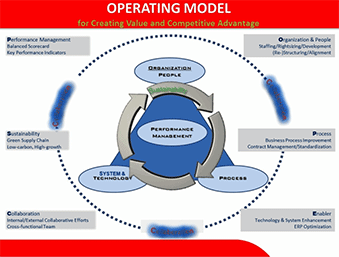Operating Model
An Operating Model is the operational design that makes it possible to deliver the Business Strategy. The operating model defines how the company will deliver the capabilities and financial outcomes the strategy requires.
An operating model covers five elements making up the acronym PILOS:
- Processes and activities – the work that needs to be done
- Information and information systems – needed to support the work
- Locations, buildings, and other assets – housing and further supporting the work
- Organisation and people – the people who do the work and how they are organized
- Sourcing and partners – those outside the organization supporting the work.
Each element of the operating model needs to be designed to contribute to the success of the organization and will have an impact on both the income statement and the balance sheet.[1]
The people element is the essence of the operating model; the organization is developed effectively where functions are run by competent personnel.
Business Process is continually reviewed for improvement and adding value, i.e., shorter cycle time and efficient process to maintain a high service level to the customers.

Source: PHE WMO
Types of Operating Models[2]
One can analyze and categorize one's company or business unit’s operating model based on four models:
- Diversification (low standardization, low integration): "Diversification applies to companies whose business units have few common customers, suppliers, or ways of doing business. Business units in diversified companies offer different products and services to different customers, so central management exercises limited control over those business units.”
- Coordination (low standardization, high integration): “Coordination calls for high levels of integration but little standardization of processes. Business units in a Coordination company share one or more of the following: customers, products, suppliers, and partners. The benefits of integration can include integrated customer service, cross-selling, and transparency across supply chain processes. While key business processes are integrated, however, business units have unique operations, often demanding unique capabilities.”
- Replication (high standardization, low integration): “Replication models grant autonomy to business units but run operations in a highly standardized fashion. In a Replication model, the company's success depends on efficient, repeatable business processes rather than on shared customer relationships. The business units are not dependent on one another's transactions or data; the success of the company as a whole is dependent on global innovation and the efficiency of all business units implementing a set of standardized business processes. Accordingly, business unit managers have limited discretion over business process design, even though they operate independently of other business units.”
- Unification (high standardization, high integration): "When organizational units are tightly integrated around a standardized set of processes, companies benefit from a Unification model. Companies applying this model find little benefit in business unit autonomy. They maximize efficiencies and customer services by presenting integrated data and driving variability out of business processes.”
See Also
References
